Porcelain Insulator News
by Elton Gish
Reprinted from "Crown Jewels of the Wire", May 1998, page 14
We usually discuss unipart or multipart pin-type porcelain insulators in PIN.
This month I would like to present a few unusual items that do not fall in this
category and which you may find interesting all the same.
The first item was
reported by Phillip Gillham (Laredo, TX) and it is not exactly an insulator. It
appears to be a decorative pottery guide plate for two electrical wires entering
a building through a wall. The two white, unglazed wall tubes shown in the
photograph fit nicely in the two holes; although, they appear to be more modern
than the guide plate. The guide plate (5-1/2" x 10-3/8" x 1-7/16"
thick) is made of pottery with a rich brown glaze and weighs 4-1/2 pounds. Note
the French word "CHAUFFEUSE" impressed in the center. This could be
the name of the company who made it, but I have a suspicion that it refers to
the intended purpose. We all know the word "chauffeur" refers to
someone driving a car for another person or more basically assisting or guiding.
Could the root word mean assist or guide? Perhaps someone with a background in
French could help us.
Phil got this unusual item from a friend who offered the
following background: "We understand that this clay tablet was used to
space the two wires used in domestic wiring in the late 1800' s. At that time,
the insulation was not as good on exterior wiring as it is today and wires
chaffing from wind action was a problem. This "chauffeuse" was found
when a farmer plowing near the site of an old plantation home near Savannah, GA
caught a copper wire. He found the insulation nearly gone on the wire. Upon
digging he unearthed this tablet and parts of two others strung on the wire. This information was provided by the lady in charge of
the antique shop in Brunswick, GA where we purchased this tablet." I'm not
sure how the "tablet" was mounted on the wall if it was a wooden wall.
Perhaps it was a brick wall in which case the "tablet" could have been
cemented to the brick. I would appreciate hearing from anyone who has additional
information on this unusual item.

Unusual "tablet" guide for electrical wires entering a building.
John de Sousa (NIA #419) reported the next insulator. I do not know exactly
how it was used. It is similar to U-190 which has a cap with a metal rod
cemented in it. I have seen the top of John's odd insulator which looks similar
to a standard pin-type insulator but this is the first time I have seen the
large bottom part. Please let me know if you have any idea how this was used.
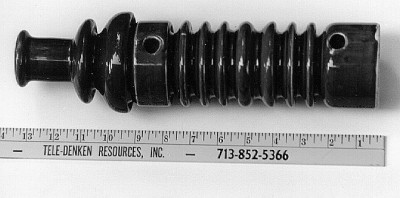
Odd 2-part insulator with pretty rusty brown glaze.
The next item is not an insulator but its use is critical in the manufacture
of porcelain insulators. A number of these have been dug up over the years at
the Pittsburg dump and perhaps collectors have found them at other porcelain
dumps, too. They are called Seger cone-plaques and were placed at various
locations in the firing kiln to indicate proper firing temperature. The older
plaques are handmade of special clay with cones stuck in the clay. Newer plaques
came preformed with holes for the cones. The composition of each cone is
different so it sags at a specific temperature and each cone is stamped with a
reference number. I recently acquired a copy of "The Potter's Corner" published by Locke in 1952 when it
was a department of General Electric. The booklet is a series of papers written
by Walter A. Weldon for the Locke News, a paper published for the employees at
the Baltimore factory. Mr. Weldon, head ceramist with Locke for many years, was
associated with Fred Locke in 1918 and came to the Baltimore factory in 1921. He
was the expert at Locke in the field of porcelain manufacture.
One of Mr.
Weldon's papers gave the following history and description of the use of Seger
cones:
The Story of the Seger Pyrometric Cones
"Here we have a very interesting story of a small item which everyone
who passes through sees on or near the kiln firing sections in our plant. You
would find these same items in factories firing or vitrifying clay products the
world over, so widespread is their use."
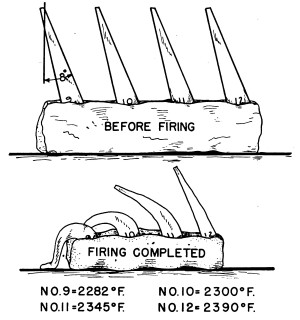
Illustrations of typical 4-cone plaques
before and after firing.
"If one cared to make a long study of systems of recording heat
characteristics, one would start back through the ages to the methods used by the early potter testing his ware from the fire. Records show
a very simple but sound early method of testing which involved placing small
pieces of the ware to be fired in the kiln and drawing them out through a small
opening in the kiln as the heat began to vitrify [the clay]. The potter would,
in some cases, study the samples for glaze action only. The writer has secured
some fine results in working with a very critical cobalt blue glaze with this
draw sample method."
"A more reliable method over all was worked out
in Germany by Dr. Herman Seger in 1886. Here you have the real beginnings of the
chemistry of the ceramic industry. The study of ceramic materials, the melting
down action, the reasons why some items melt at low temperatures and others at
very high temperatures were all worked out from this principle."
"The
use of Dr. Seger's system of pyrometric cones quickly spread over the face of the
earth as other scientific organizations took up his work. Here in the United
States General Edward Orton, Jr., stepped into the picture in 1894 and created,
at Ohio State University, the first college course in ceramic engineering
offered in this country. Simultaneously, General Orton started to manufacture
pyrometric cones."
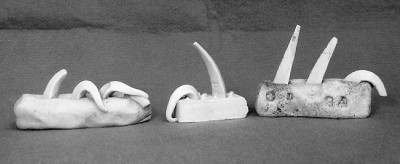
Three old sets of firing cone-plaques found in the Pittsburg dump.
Plaque on
the left has typical set of four cones (Nos. 12-11-10-9).
Center is one half of
a 4-cone plaque (Nos. 11-12).
Right is a 3-cone plaque containing an odd set of
cones (Nos. 11-10-8).
"Through application of these cones, manufacturers were able to obtain far greater uniformity of their ware regardless of
the size and kind of kiln or fuel used. Because of General Orton's great interest and devotion to the ceramic industry,
he decreed in his will that the Standard Pyrometric Cone Company should be left in trust to be operated for the benefit of ceramic research and
advancement. This company is administered by a board of trustees consisting of representatives from the Ohio State
University, the National Bureau of Standards, and the American Ceramic Society. This board maintains Fellowships at several
universities. "
"There are, in all, 61 different cone numbers in the American series. The lowest cone, No. 022, is a soda-lead
borosilicate glass and the highest cone, No. 42, is pure aluminum oxide. Within the temperature ranges used for firing gold, colors,
glazes, and ceramic products. Also, the pyrometric cone equivalent value of nearly all ceramic materials or products comes
within this range. This permits the use of cones for determining
the property called deformation temperature, or melting point."
|
"The four groups of 61 cones are:
|
|
Group No.1 - The soft series: |
Cones 022-011 |
1085 F to 1607 F |
|
Group No.2 - The low temperature
series: |
Cones 010-01 |
1634 F to 2030 F |
|
Group No. 2A - The iron-free series |
Cones 010-3 |
1634 F to 2093 F |
|
Group No.3
- The intermediate temp series: |
Cones 1-20 |
2057 F to 2768 F |
|
Group No.4 - The high temperature
series: |
Cones 23-42 |
2876 F to
3659 F |
"Here at Locke we use the No.3 series. We also have a number of other
heat-recording devices upon our kilns."
Typically, cones 9, 10, 11, and 12
are used for firing porcelain insulators. All four cones are placed in a lump of
clay at a slight angle of 8 degrees. Each cone represents the following
temperatures: No.9 = 2282F; No. 10 = 2300F; No. 11 = 2345F, and No. 12 = 2390F.
Each cone will sag when the corresponding temperature for that specific cone is
reached in the kiln. The temperature in the kiln is brought up very slowly to
maintain a uniform temperature in the kiln. When the kiln temperature finally
reaches the desired level (in some cases about 2350F), the firing is complete
and the kiln temperature is gradually lowered.
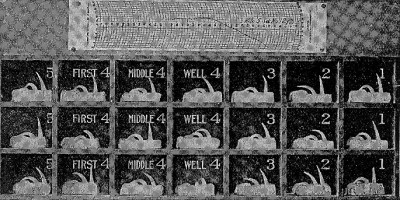
Group of 21 cone-plaques removed from a kiln
at Pittsburg High Voltage Insulator Co.
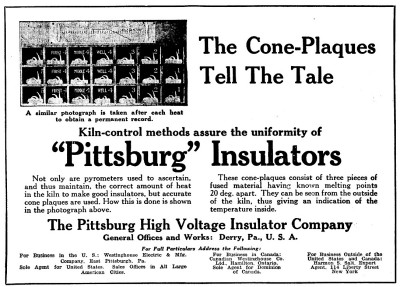
Advertisement from November 13, 1920 issue of Electrical World.
Note that the
ad says the cone-plaques "consist of three pieces".
Obviously the
person who wrote the article did not know
that each cone-plaque contained four
cones.
The Origin of the Name Porcelain:
Pottery is not porcelain. Porcelain is the
most highly organized expression of the potter's art. Porcelain is a thing
separate and distinct from pottery, because there is a fundamental difference
between the body of porcelain and the mixes or bodies of all the various sorts
of pottery and earthenware. Calling porcelain insulators "mud" is
ignoring the basic art of porcelain manufacture. Electrical wet process
porcelain is equivalent to the finest Haviland china in quality - which is
impossible to make from mud.
For those of you who have wondered where the name
porcelain came from, Mr. Weldon offers the following explanation: "The
transition period of stoneware to porcelain took place in the T'ang Dynasty
(A.D. 617-906). It was an age of splendor for all the arts in China, and the
potter's art was in no way behind the rest. From the providence of Tzu Chou the
white ware became famous throughout China and began to filter through the trade
routes, and in time found its way into Europe. In China, this ware was called
Tzu or Tzu Chou ware, or "the white ware of the north", for the city
of Tzu Chou was near Pekin. The name porcelain did not appear until much
later."
"For a number of years in Europe, fine examples of ware from
the far east were also called "Gombroom" ware, from the early English
trading post of Gombroom on the Persian Gulf, whence the Chinese porcelains were
sent into Europe. When the East India Company had obtained a concession in
Canton about 1640, the name was gradually changed to "China ware", as
it was imported into Europe. After the opening up of the sea route to China, the
first European vessel landing on Chinese shores in the year 1517, only half a
century elapsed before the Portuguese founded their first warehouse at Macao,
near Canton, in 1567."
"The Portuguese navigators of the late 15th and
16th centuries were the first to spread the ware in large quantities into Europe
and through them it began to take the name porcelain from the word "porcellana"
meaning a small bright-polished shell. This shell is found on the shores of the
Mediterranean Sea. "Porcella", diminutive of "porco", or
"pig", is derived from a supposed resemblance of the shell to a pig's
back."
| 